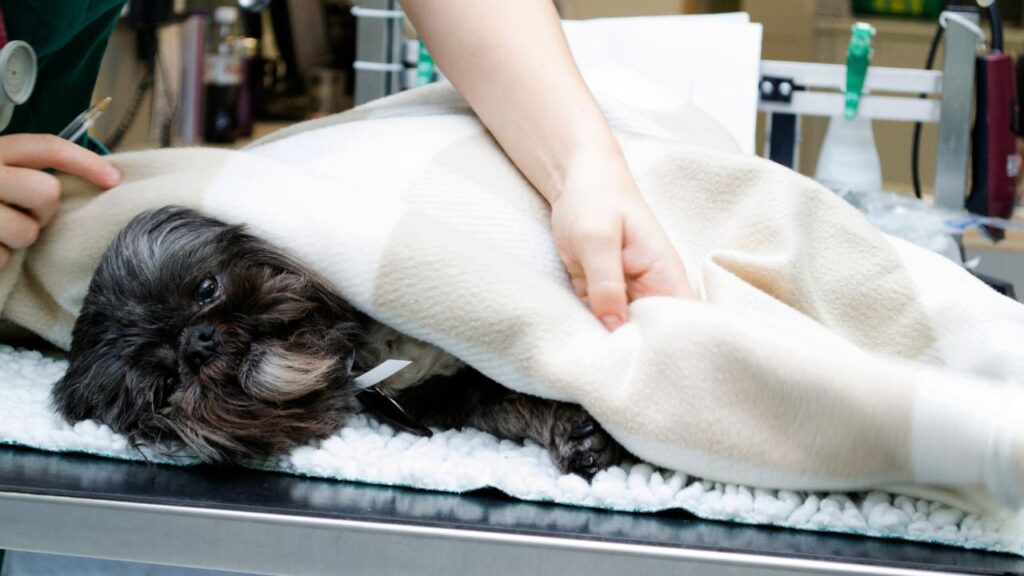Bone marrow plays a pivotal role in the creation of red blood cells, white blood cells, and platelets, which are critical for a dog’s health. Many cancer treatments cause bone marrow suppression in dogs, but there are many ways veterinarians can use to give the bone marrow a boost and help get it back on track.
Key Takeaways
- Bone marrow suppression is treated in dogs with blood transfusions, a high-protein diet, iron supplementation, and/or medications to stimulate the bone marrow.
- The symptoms of bone marrow disease in dogs include lethargy, weakness, chronic infections, and unusual bruising.
- Bone marrow suppression is serious if it is not caught and treated early.
- Bone marrow suppression can be cured, especially when it is caught early.
- A dog with mild bone marrow disease may be able to live quite some time with proper care, but severe bone marrow disease can be fatal.
What Is Bone Marrow Suppression in Dogs?
Bone marrow is a spongy material found inside many of the bones in the body. It contains stem cells that develop into red and white blood cells and platelets. Once these cells are fully developed, they are released from the marrow into the blood stream. Bone marrow suppression in dogs is a significant side effect of some cancer treatments.
Healthy bone marrow is important for three primary functions:1
- To support the immune system
- To help maintain proper oxygen levels
- To support normal blood clotting abilities
When the bone marrow is suppressed, all of these areas can suffer. The bone marrow is no longer producing enough white blood cells to fight infection, enough red blood cells to deliver oxygen throughout the body, and/or enough platelets for proper clotting.
The medical term for bone marrow suppression is myelosuppression.
Signs of Bone Marrow Suppression in Dogs
Clinical symptoms of bone marrow suppression are caused because the bone marrow is no longer able to produce adequate amounts of the blood cells that perform important jobs throughout the body.2
Symptoms include:
- Weakness
- Lethargy
- Apathy
- Loss of appetite
- Chronic infections
- Abnormal bruising
Why Bone Marrow Suppression in Dogs Happens
Several factors can contribute to bone marrow suppression (myelosuppression) in dogs.
Some common causes include:2
- Infection
- Nutritional deficiencies
- Diseases
- Toxins
- Exposure to radiation
- Exposure to chemotherapy drugs
In dogs undergoing treatment for cancer, bone marrow suppression is most likely to be seen in dogs who are being treated with chemotherapy. This occurs because the bone marrow contains cells that are dividing and growing rapidly and most chemotherapy drugs target rapidly dividing cells.2
Cancer Treatments That Can Cause Bone Marrow Suppression
Dogs receiving anti-cancer and immune suppressive medications can develop bone marrow suppression.
Many chemotherapy drugs used in dogs can cause bone marrow suppression. This is because many chemo drugs work by targeting rapidly dividing cells – the intention is to kill the rapidly dividing cancer cells, but bone marrow cells are also rapidly dividing and can get caught in the crossfire. Bone marrow suppression typically occurs 7-10 days after the chemotherapy is administered.3
Radiation therapy can cause bone marrow suppression when it is used to target tumor cells in the bone marrow. Unfortunately, getting rid of the tumor cells in the bone marrow also means destroying the healthy bone marrow cells. This treatment is typically used before a bone marrow transplant, so your dog’s bone marrow will be replenished afterward.
Cancers that Directly Cause Bone Marrow Suppression
- Sertoli cell tumors are a common cancer in intact, male dogs, especially cryptorchid dogs. These tumors secrete estrogen, a hormone that dramatically suppresses bone marrow production.4
- Leukemia can cause an overgrowth of one abnormal cell type which then crowds out the other cells in the bone marrow, leading to overall bone marrow suppression.5
Other cancers can also cause bone marrow suppression as well.
When to Call Your Vet
Please alert your veterinarian and seek medical care if your dog experiences these symptoms:
- Lethargy: tired and not as energetic as before
- Fever
- Recurrent infections: routine infections of the skin, ear, or urinary bladder that go away with antibiotic therapy but quickly come back
- Petechial hemorrhage: small purple or red dots on the nose, gums, eyes, or skin that suggest a lack of clotting factors
- Blood in urine (hematuria)
- Nosebleed (epistaxis)
- Black-colored feces (melena)
- Pale gums
- Weakness
- Pica: a desire to chew ice or non-food items, including dirt
Most of these symptoms can be caused by a variety of health conditions, and do not guarantee that your dog has bone marrow suppression. An exam is important so that your vet can figure out what is going on and start treatment as soon as possible.
Your vet will likely recommend some tests to determine if your dog’s bone marrow is suppressed and figure out the cause. Diagnostic tests may include:
- Complete blood cell count, immunoglobulin profile, and chemistry panel bloodwork
- Coagulation profile to check clotting ability
- Urinalysis
- Radiographs (x-rays) or ultrasound of the chest and abdomen
- Bone marrow cytology and/or biopsy
Things that Help Bone Marrow Suppression in Dogs
There are a variety of ways to support a healthy bone marrow. Some of these are things that you can do at home, and others are therapies that your veterinarian can provide.
At-Home Therapies
You can support your dog’s bone marrow with high quality dietary choices such as:
- Diet rich in protein, iron, and B-vitamins and folate. Lean meats, eggs, yogurt, and fish are some of the best protein sources for dogs.
- Feed a complete and balanced diet to ensure that your dog is getting everything his body needs, including the 13 essential vitamins. In particular, B vitamins play a vital role in supporting healthy red blood cell production6 often.
- A dog with bone marrow suppression should not get raw foods. Their immunocompromise makes them more likely to get sick from lingering bacteria or viruses. Keep in mind that bacteria are on raw vegetables as often as they are on meat, so cook even veggies.
There are immune-supportive supplements you can ask your veterinarian about. For example, medicinal mushroom supplements have been shown to help manage side effects of dogs experiencing decreased white blood cell counts secondary to chemotherapy.7
Other general healthy habits that support your dog’s immunity are:
- Encourage your dog to stay hydrated and eat well.
- Plenty of rest. Bone marrow suppression can cause lethargy and general malaise, so dogs should be allowed to rest and recuperate while they are recovering from bone marrow suppression.
- Avoid areas with lots of other dogs such as dog parks, grooming facilities, and boarding kennels. This will help to protect your dog from infections while he is vulnerable.
Medical Therapies
Your veterinarian will start by figuring out why your dog’s bone marrow is suppressed. Once she knows the cause, she will be able to choose the best treatment.
Some treatment options include:4,9,10
- Antibiotics to prevent or treat infection
- Fluid therapy and supportive care
- Blood transfusions (typically only recommended for severe cases)
- Drugs to stimulate bone marrow activity, such as NEUPOGEN or others
Is Bone Marrow Suppression a Sign My Dog Is Dying?
Dogs with compromised bone marrow function are often already very sick due to their cancer or due to the treatments they are receiving. Depending on the cause of the bone marrow suppression, the prognosis varies drastically.
For dogs who are experiencing bone marrow suppression due to chemotherapy or other treatments, most dogs will make a strong recovery over weeks to months once they receive treatment and supportive care. Your oncologist may adjust his treatment protocols to prevent future episodes of bone marrow suppression.3
For lymphoma patients, research has shown that dogs who experienced low neutrophil (a type of white blood cell) counts after CHOP-based chemotherapy treatment have a longer remission and overall survival time compared to dogs who do not have low neutrophil counts after treatment.8 So mild symptoms of bone marrow suppression may indicate that your dog will do well overall.
For dogs who are experiencing bone marrow suppression due to advanced cancer or other illness, the prognosis is poorer and may require more advanced treatments and care. Complete bone marrow suppression (ablation) that cannot be restored is typically fatal.
Unfortunately, many dogs do not adequately recover from severe disease and bone marrow suppression, and families are faced with making a decision to euthanize based on their pet’s quality of life.
- Hays K. Physiology of normal bone marrow. Semin Oncol Nurs. 1990;6(1):3-8. doi:10.1016/s0749-2081(05)80127-5
- MacDonald V. Chemotherapy: managing side effects and safe handling. Can Vet J. 2009;50(6):665-668.
- Chemotherapy. University of Missouri Veterinary Health Center. https://vhc.missouri.edu/small-animal-hospital/oncology/cancer-treatment/chemotherapy/. Published March 16, 2016. Accessed April 7, 2023.
- Salyer, S. A., Lapsley, J. M., Palm, C. A., Culp, W. T. N., Lundberg, A. P., Phillips, H., McKenna, C., Oblak, M. L., Hall, R., Wustefeld-Janssens, B., Tremolada, G., & Selmic, L. E. (2022). Outcome of dogs with bone marrow suppression secondary to Sertoli cell tumour. Veterinary and comparative oncology, 20(2), 484–490. https://doi.org/10.1111/vco.12794
- Leukemia types. eClinpath. (2020, June 25). Retrieved February 22, 2023, from https://eclinpath.com/hematology/leukemia/leukemia-types/
- Braunstein, E. M. (2023, February 14). Red Blood Cell Production. Merck Manuals Professional Edition. Retrieved February 22, 2023, from https://www.merckmanuals.com/professional/hematology-and-oncology/approach-to-the-patient-with-anemia/red-blood-cell-production
- Holliday, J. C., Gianotti, B. M., Cleaver, M. P., Mullins, M. N., & West, S. Y. (2009). Preclinical evaluation of concurrent medicinal mushroom-based immune-enhancement supplementation in dogs undergoing chemotherapy for various cancers. International Journal of Medicinal Mushrooms, 11(2), 167–184. https://doi.org/10.1615/intjmedmushr.v11.i2.60
- Wang, S. L., Lee, J. J., & Liao, A. T. (2015). Chemotherapy-induced neutropenia is associated with prolonged remission duration and survival time in canine lymphoma. Veterinary journal (London, England : 1997), 205(1), 69–73. https://doi.org/10.1016/j.tvjl.2015.04.032
- Kobayashi T. Management of chemotherapy side effects – WSAVA 2015 Congress – Vin. Veterinary Information Network. https://www.vin.com/apputil/content/defaultadv1.aspx?pId=14365&catId=73692&id=7259173. Published 2015. Accessed April 7, 2023.
- Palacios M, Arteaga R, Calvo G. High-dose filgrastim treatment of nonregenerative pancytopenia associated with chronic canine ehrlichiosis. Topics in Companion Animal Medicine. 2017;32(1):28-30. doi:10.1053/j.tcam.2017.05.005
Topics
Did You Find This Helpful? Share It with Your Pack!
Use the buttons to share what you learned on social media, download a PDF, print this out, or email it to your veterinarian.





